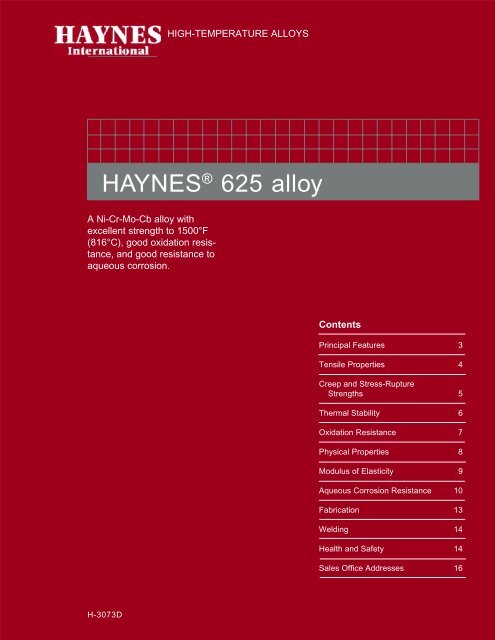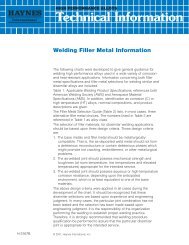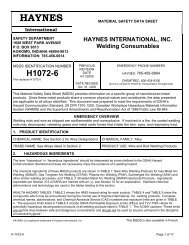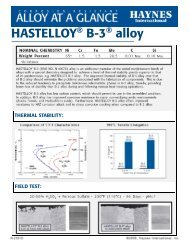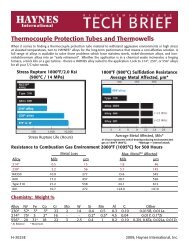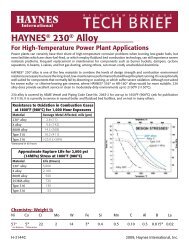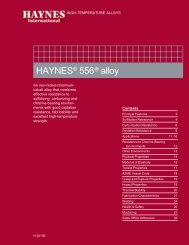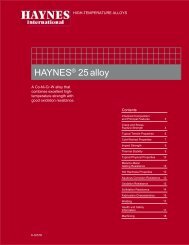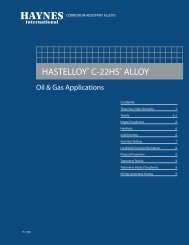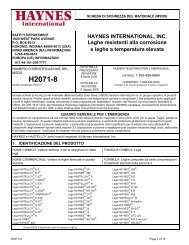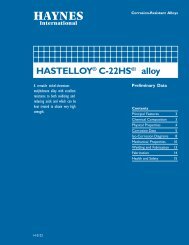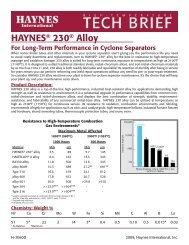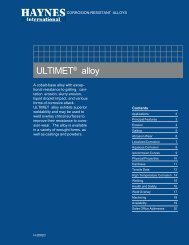HAYNES ® 625 alloy Brochure - Haynes International, Inc.
HAYNES ® 625 alloy Brochure - Haynes International, Inc.
HAYNES ® 625 alloy Brochure - Haynes International, Inc.
Create successful ePaper yourself
Turn your PDF publications into a flip-book with our unique Google optimized e-Paper software.
HIGH-TEMPERATURE ALLOYS<br />
<strong>HAYNES</strong> <strong>®</strong> <strong>625</strong> <strong>alloy</strong><br />
A Ni-Cr-Mo-Cb <strong>alloy</strong> with<br />
excellent strength to 1500°F<br />
(816°C), good oxidation resistance,<br />
and good resistance to<br />
aqueous corrosion.<br />
Contents<br />
Principal Features 3<br />
Tensile Properties 4<br />
Creep and Stress-Rupture<br />
Strengths 5<br />
Thermal Stability 6<br />
Oxidation Resistance 7<br />
Physical Properties 8<br />
Modulus of Elasticity 9<br />
Aqueous Corrosion Resistance 10<br />
Fabrication 13<br />
Welding 14<br />
Health and Safety 14<br />
Sales Office Addresses 16<br />
H-3073D
<strong>HAYNES</strong> <strong>625</strong> <strong>alloy</strong><br />
2 © 2001, by <strong>Haynes</strong> <strong>International</strong>, <strong>Inc</strong>.
PRINCIPAL FEATURES<br />
Excellent Strength Up To<br />
1500°F (816°C), Good<br />
Oxidation Resistance,<br />
and Good Resistance to<br />
Aqueous Corrosion<br />
<strong>HAYNES</strong> <strong>®</strong> <strong>625</strong> <strong>alloy</strong> is a nickelchromium-molybdenum<br />
<strong>alloy</strong><br />
with excellent strength from<br />
room temperature up to about<br />
1500°F (816°C). At higher<br />
temperatures, its strength is<br />
generally lower than that of<br />
other solid-solution strengthened<br />
<strong>alloy</strong>s. Alloy <strong>625</strong> has<br />
good oxidation resistance at<br />
temperatures up to 1800°F<br />
(980°C) and provides good<br />
resistance to aqueous corrosion,<br />
but generally not as<br />
effectively as modern<br />
HASTELLOY <strong>®</strong> corrosionresistant<br />
<strong>alloy</strong>s.<br />
Easily Fabricated<br />
<strong>HAYNES</strong> <strong>625</strong> <strong>alloy</strong> has excellent<br />
forming and welding<br />
characteristics. It may be<br />
forged or otherwise hot-worked<br />
providing temperature is<br />
maintained in the range of<br />
about 1800 to 2150°F (980 to<br />
1175°C). Ideally, to control<br />
grain size, finish hot working<br />
operations should be performed<br />
at the lower end of the temperature<br />
range. Because of its good<br />
ductility, <strong>alloy</strong> <strong>625</strong> is also<br />
readily formed by cold working.<br />
However, the <strong>alloy</strong> does workharden<br />
rapidly so intermediate<br />
annealing treatments may be<br />
needed for complex component<br />
forming operations.<br />
In order to restore the best<br />
balance of properties, all hot- or<br />
cold-worked parts should be<br />
annealed and rapidly cooled<br />
The <strong>alloy</strong> can be welded by<br />
both manual and automatic<br />
welding methods, including gas<br />
tungsten arc (GTAW), gas<br />
metal arc (GMAW), electron<br />
beam, and resistance welding.<br />
It exhibits good restraint welding<br />
characteristics.<br />
Heat Treatment<br />
Unless otherwise specified,<br />
wrought <strong>HAYNES</strong> <strong>625</strong> <strong>alloy</strong> is<br />
normally supplied in the millannealed<br />
condition. The <strong>alloy</strong><br />
is usually mill-annealed at<br />
1925°F plus or minus 25°F<br />
(1050°C plus or minus 15°C) for<br />
a time commensurate with<br />
section thickness and rapidly<br />
cooled or water-quenched for<br />
optimum properties. Depending<br />
on customer requirements, <strong>alloy</strong><br />
<strong>625</strong> may also be supplied<br />
solution heat-treated at temperatures<br />
at or above 2000°F<br />
(1095°C), or mill annealed at<br />
temperatures below 1925°F<br />
(1050°C). Lower temperature<br />
mill annealing treatments may<br />
result in some precipitation of<br />
second phases in <strong>alloy</strong> <strong>625</strong><br />
which can affect the <strong>alloy</strong>’s<br />
properties.<br />
Available in Convenient<br />
Forms<br />
<strong>HAYNES</strong> <strong>625</strong> <strong>alloy</strong> is produced<br />
in the form of plate, sheet, strip,<br />
billet, bar, wire, pipe, and<br />
tubing.<br />
Applications<br />
<strong>HAYNES</strong> <strong>625</strong> <strong>alloy</strong> is widely<br />
used in a variety of hightemperature<br />
aerospace, chemical<br />
process industry, and power<br />
industry applications. It provides<br />
excellent service in shortterm<br />
applications at temperatures<br />
up to approximately<br />
1500°F (815°C); however, for<br />
long-term elevated temperature<br />
service, use of <strong>alloy</strong> <strong>625</strong> is best<br />
restricted to a maximum of<br />
1100°F (595°C). Long-term<br />
thermal exposure of <strong>alloy</strong> <strong>625</strong><br />
above 1100°F (595°C) will<br />
result in significant<br />
embrittlement. For service at<br />
these temperatures, more<br />
modern materials, such as<br />
<strong>HAYNES</strong> 230 <strong>®</strong> <strong>alloy</strong>, are<br />
recommended.<br />
As a low-temperature corrosionresistant<br />
material, <strong>alloy</strong> <strong>625</strong> has<br />
been widely used in chemical<br />
process industry, sea water,<br />
and power plant scrubber<br />
applications. However, in most<br />
current requirements it has<br />
largely been superceded by<br />
more capable HASTELLOY<br />
<strong>alloy</strong>s, such as C-22 <strong>®</strong> and<br />
G-30 <strong>®</strong> <strong>alloy</strong>s.<br />
Applicable Specifications<br />
<strong>HAYNES</strong> <strong>625</strong> <strong>alloy</strong> is covered<br />
by the following specifications:<br />
AMS 5599 (sheet, strip and<br />
plate), AMS 5666 (bar, rings,<br />
and forgings), AMS 5837 (wire);<br />
ASTM B-443 (sheet and plate),<br />
ASTM B-446 (bar and rod),<br />
AWS A5.14 (wire). The UNS<br />
number for this material is<br />
N06<strong>625</strong>.<br />
Nominal Chemical Composition, Weight Percent<br />
Ni Co Fe Cr Mo Cb+Ta Mn Si Al Ti C<br />
62 a 1* 5* 21 9 3.7 0.5* 0.5* 0.4* 0.4* 0.10*<br />
a<br />
As Balance<br />
* Maximum<br />
3<br />
<strong>HAYNES</strong> <strong>625</strong> <strong>alloy</strong>
TYPICAL TENSILE PROPERTIES<br />
Cold-Rolled and 1925°F (1050°C) Mill-Annealed (Sheet)<br />
Ultimate<br />
Test Tensile Yield Strength Elongation in<br />
Temperature Strength at 0.2% Offset 2 in. (50.8 mm)<br />
°F °C Ksi MPa Ksi MPa %<br />
Room Room 131.1 905 71.1 490 48.5<br />
1000 540 111.6 770 53.7 370 54.0<br />
1200 650 110.1 760 53.7 370 55.6<br />
1400 760 87.2 600 50.2 345 53.1<br />
1600 870 50.0 345 29.7 205 45.9<br />
1800 980 24.1 165 12.1 83 43.8<br />
2000 1095 13.7 95 5.6 39 44.7<br />
Hot-Rolled and 1925°F (1050°C) Mill-Annealed (Plate)<br />
Ultimate<br />
Test Tensile Yield Strength Elongation in<br />
Temperature Strength at 0.2% Offset 2 in. (50.8 mm)<br />
°F °C Ksi MPa Ksi MPa %<br />
Room Room 129.5 895 71.3 490 43.8<br />
Comparative Elevated Temperature Yield Strengths (Sheet)<br />
Temperature, °C<br />
RT 500 600 700 800 900 1000 1100<br />
Stress, Ksi<br />
90<br />
80<br />
70<br />
60<br />
50<br />
40<br />
<strong>625</strong><br />
0.2% Yield Strength<br />
Sheet<br />
188<br />
600<br />
500<br />
400<br />
300<br />
Stress, MPa<br />
30<br />
200<br />
20<br />
10<br />
230¨ <strong>alloy</strong><br />
X<br />
100<br />
RT 1000<br />
1200 1400 1600<br />
Temperature, °F<br />
1800 2000<br />
<strong>HAYNES</strong> <strong>625</strong> <strong>alloy</strong><br />
4
CREEP AND STRESS-RUPTURE STRENGTHS<br />
Cold-Rolled and 1925°F (1050°C) Mill-Annealed (Sheet)<br />
Test<br />
Approximate Initial Stress, Ksi (MPa)<br />
Temperature Creep, to Produce Specified Creep in<br />
°F °C Percent 10 Hours 100 Hours 1,000 Hours<br />
1200 650 0.5 50.5 (350) 36.0 (250) 23.5 (160)<br />
1.0 58.0 (400) 40.0 (275) 25.0 (170)<br />
Rupture -- -- 77.0 (530) 55.0 (380)<br />
1300 705 0.5 32.5 (225) 20.0 (140) 12.0 (83)<br />
1.0 35.0 (240) 22.0 (150) 13.7 (95)<br />
Rupture 70.0 (485) 49.5 (340) 32.0 (220)<br />
1400 760 0.5 18.4 (125) 10.3 (71) 6.0 (41)<br />
1.0 20.0 (140) 12.3 (85) 7.2 (50)<br />
Rupture 45.0 (310) 29.0 (200) 17.8 (125)<br />
1500 815 0.5 9.7 (67) 5.4 (37) 2.9 (20)<br />
1.0 11.3 (78) 6.6 (45) 3.7 (25)<br />
Rupture 26.5 (185) 16.2 (110) 9.1 (63)<br />
1600 870 0.5 5.2 (36) 2.7 (19) 1.5 (10)<br />
1.0 6.2 (43) 3.5 (24) 1.7 (12)<br />
Rupture 15.3 (105) 8.6 (59) 4.2 (29)<br />
1700 925 0.5 2.7 (19) 1.5 (10) - -<br />
1.0 3.4 (23) 1.7 (12) - -<br />
Rupture 8.3 (57) 4.1 (28) 2.7 (19)<br />
1800 980 0.5 1.5 (10) - - - -<br />
1.0 1.7 (12) - - - -<br />
Rupture 4.1 (28) 2.7 (19) 1.7 (12)<br />
Comparison of Stress to Produce 1% Creep in 1000 Hours (Sheet)<br />
Temperature, °C<br />
650 700 750 800 850 900 950 1000<br />
30<br />
20<br />
230¨ <strong>alloy</strong><br />
200<br />
15<br />
188<br />
100<br />
Stress, Ksi<br />
10<br />
9<br />
8<br />
7<br />
6<br />
5<br />
4<br />
<strong>625</strong><br />
50<br />
Stress, MPa<br />
3<br />
20<br />
2<br />
X<br />
10<br />
1<br />
1200 1300<br />
1400 1500 1600<br />
Temperature, °F<br />
1700<br />
1800<br />
5<br />
<strong>HAYNES</strong> <strong>625</strong> <strong>alloy</strong>
THERMAL STABILITY<br />
<strong>HAYNES</strong> <strong>®</strong> <strong>625</strong> <strong>alloy</strong> is similar to<br />
the solid-solution-strengthened<br />
super<strong>alloy</strong>s, such as <strong>HAYNES</strong><br />
188 <strong>alloy</strong> or HASTELLOY <strong>®</strong> X<br />
<strong>alloy</strong>, which will precipitate<br />
deleterious phases upon longterm<br />
exposure at intermediate<br />
temperatures. In this case, the<br />
phase in question is Ni 3<br />
Cb deltaphase<br />
which serves to impair<br />
both tensile ductility and impact<br />
strength. For applications where<br />
thermal stability is important,<br />
230 <strong>®</strong> <strong>alloy</strong> is recommended.<br />
Room Temperature Tensile Elongation (%)<br />
70<br />
60<br />
50<br />
40<br />
30<br />
20<br />
10<br />
Exposure Temperature (°C)<br />
RT 500 600 700 800 900 1000<br />
Retained Room Temperature<br />
Tensile Ductility after 8000<br />
Hour Exposure at Temperature<br />
X<br />
<strong>625</strong><br />
230 <strong>alloy</strong><br />
188<br />
RT 1000 1200 1400 1600 1800<br />
Exposure Temperature (°F)<br />
Room Temperature Properties After Thermal Exposure (Plate)<br />
Ultimate<br />
Exposure Tensile Yield Strength Elongation in Impact<br />
Temperature Strength at 0.2% Offset 2 in. (50.8mm) Strength<br />
°F °C Hours Ksi MPa Ksi MPa % ft.-lb. Joules<br />
As-Annealed* 127.7 880 66.2 455 46 81 110<br />
1200 650 1000 165.0 1140 122.3 845 28 11 15<br />
4000 163.6 1130 117.9 815 24 8 11<br />
8000 164.2 1130 117.8 810 18 5 7<br />
16000 165.4 1140 118.5 815 12 4 5<br />
1400 760 1000 142.9 985 95.5 660 17 5 7<br />
4000 145.5 1005 104.1 720 12 4 5<br />
8000 142.6 985 97.4 670 13 5 7<br />
16000 140.4 970 96.1 665 12 4 5<br />
1600 870 1000 130.0 895 68.3 470 30 12 16<br />
4000 130.0 895 66.4 460 29 11 15<br />
8000 127.0 875 63.7 440 26 15 20<br />
16000 128.4 885 63.4 435 32 14 19<br />
*1875°F (1025°C), rapid cooled<br />
<strong>HAYNES</strong> <strong>625</strong> <strong>alloy</strong><br />
6
OXIDATION RESISTANCE<br />
Comparative Burner Rig Oxidation Resistance (1000 Hours)<br />
Burner rig oxidation tests were<br />
conducted by exposing samples<br />
3/8 in. x 2.5 in. x thickness (9<br />
mm x 64 mm x thickness), in a<br />
rotating holder, to products of<br />
combustion of a mixture of<br />
No. 1 and No. 2 fuel oil. This<br />
was burned at a ratio of air to<br />
fuel of about 50:1 for 1000<br />
hours. (Gas velocity was about<br />
0.3 mach). Samples were<br />
automatically removed from the<br />
gas stream every 30 minutes,<br />
fan-cooled to near ambient<br />
temperature, and then reinserted<br />
into the flame tunnel.<br />
1800°F (980°C)<br />
Metal Average Maximum<br />
Loss Metal Affected Metal Affected<br />
Material Mils µm Mils µm Mils µm<br />
<strong>HAYNES</strong> <strong>®</strong> 230 <strong>®</strong> <strong>alloy</strong> 0.8 20 2.8 71 3.5 89<br />
HASTELLOY <strong>®</strong> X <strong>alloy</strong> 2.7 69 5.6 142 6.4 153<br />
<strong>HAYNES</strong> <strong>625</strong> <strong>alloy</strong> 4.9 124 7.1 180 7.6 193<br />
<strong>HAYNES</strong> 25 <strong>alloy</strong> 6.2 157 8.3 211 8.7 221<br />
MULTIMET <strong>®</strong> <strong>alloy</strong> 11.8 300 14.4 366 14.8 376<br />
Alloy 800H 12.7 312 14.5 368 15.3 389<br />
Oxidation Resistance in Flowing Air (1008 Hours)<br />
The following are static oxidation<br />
test rankings for 1008-hour<br />
exposures in flowing air.<br />
The samples were cycled to<br />
room temperature weekly.<br />
Average metal affected is<br />
the sum of metal loss plus<br />
average internal penetration.<br />
1800°F (980°C) 2000°F (1095°C)<br />
Metal Average Metal Average<br />
Loss Metal Affected Loss Metal Affected<br />
Material Mils µm Mils µm Mils µm Mils µm<br />
230 <strong>alloy</strong> 0.3 8 0.7 18 0.5 13 1.3 33<br />
X <strong>alloy</strong> 0.3 8 0.9 23 1.5 38 2.6 66<br />
<strong>625</strong> <strong>alloy</strong> 0.3 8 0.7 18 3.3 84 4.8 122<br />
<strong>alloy</strong> 800H 0.9 23 1.8 46 5.4 137 7.4 188<br />
25 <strong>alloy</strong> 0.4 10 0.7 18 9.2 234 10.2 259<br />
MULTIMET <strong>alloy</strong> 0.4 10 1.3 33 8.9 226 11.6 295<br />
7<br />
<strong>HAYNES</strong> <strong>625</strong> <strong>alloy</strong>
TYPICAL PHYSICAL PROPERTIES<br />
Temperature, °F British Units Temperature, °C Metric Units<br />
Density Room 0.305 lb/in 3 Room 8.44 g/cm 3<br />
Melting Range 2350-2460 1290-1350<br />
Electrical Room 50.8 microhm-in. Room 129 microhm-cm<br />
Resistivity 200 52.0 microhm-in. 100 132 microhm-cm<br />
400 52.8 microhm-in. 200 134 microhm-cm<br />
600 53.1 microhm-in. 300 135 microhm-cm<br />
800 53.5 microhm-in. 400 136 microhm-cm<br />
1000 54.3 microhm-in. 500 137 microhm-cm<br />
1200 54.3 microhm-in. 600 138 microhm-cm<br />
1400 53.9 microhm-in. 700 138 microhm-cm<br />
1600 53.5 microhm-in. 800 137 microhm-cm<br />
1800 53.1 microhm-in. 900 136 microhm-cm<br />
1000 135 microhm-cm<br />
Thermal Room 68 Btu-in./ft. 2 hr.-°F Room 9.8 W/m-K<br />
Conductivity 200 75 Btu-in./ft. 2 hr.-°F 100 10.9 W/m-K<br />
400 87 Btu-in./ft. 2 hr.-°F 200 12.5 W/m-K<br />
600 98 Btu-in./ft. 2 hr.-°F 300 13.9 W/m-K<br />
800 109 Btu-in./ft. 2 hr.-°F 400 15.3 W/m-K<br />
1000 121 Btu-in./ft. 2 hr.-°F 500 16.9 W/m-K<br />
1200 132 Btu-in./ft. 2 hr.-°F 600 18.3 W/m-K<br />
1400 144 Btu-in./ft. 2 hr.-°F 700 19.8 W/m-K<br />
1600 158 Btu-in./ft. 2 hr.-°F 800 21.5 W/m-K<br />
1800 175 Btu-in./ft. 2 hr.-°F 900 23.4 W/m-K<br />
1000 25.6 W/m-K<br />
Specific Heat Room 0.098 Btu/lb.-°F Room 410 J/Kg-K<br />
200 0.102 Btu/lb.-°F 100 428 J/Kg-K<br />
400 0.109 Btu/lb.-°F 200 455 J/Kg-K<br />
600 0.115 Btu/lb.-°F 300 477 J/Kg-K<br />
800 0.122 Btu/lb.-°F 400 503 J/Kg-K<br />
1000 0.128 Btu/lb.-°F 500 527 J/Kg-K<br />
1200 0.135 Btu/lb.-°F 600 552 J/Kg-K<br />
1400 0.141 Btu/lb.-°F 700 576 J/Kg-K<br />
1600 0.148 Btu/lb.-°F 800 600 J/Kg-K<br />
1800 0.154 Btu/lb.-°F 900 <strong>625</strong> J/Kg-K<br />
1000 648 J/Kg-K<br />
<strong>HAYNES</strong> <strong>625</strong> <strong>alloy</strong><br />
8
Typical Physical Properties<br />
Temperature, °F British Units Temperature, °C Metric Units<br />
Mean Coefficient 70-200 7.1 microinches/in.-°F 25-100 12.8 10 -6 µ/m-°C<br />
of Thermal 70-400 7.3 microinches/in.-°F 25-200 13.1 10 -6 µ/m-°C<br />
Expansion 70-600 7.5 microinches/in.-°F 25-300 13.4 10 -6 µ/m-°C<br />
70-800 7.7 microinches/in.-°F 25-400 13.8 10 -6 µ/m-°C<br />
70-1000 8.0 microinches/in.-°F 25-500 14.2 10 -6 µ/m-°C<br />
70-1200 8.4 microinches/in.-°F 25-600 14.8 10 -6 µ/m-°C<br />
70-1400 8.7 microinches/in.-°F 25-700 15.4 10 -6 µ/m-°C<br />
70-1600 9.2 microinches/in.-°F 25-800 16.0 10 -6 µ/m-°C<br />
70-1800 9.6 microinches/in.-°F 25-900 16.7 10 -6 µ/m-°C<br />
25-1000 17.4 10 -6 µ/m-°C<br />
DYNAMIC MODULUS OF ELASTICITY<br />
Temperature, °F British Units Temperature, °C Metric Units<br />
Room 30.2 x 10 6 psi Room 208 GPa<br />
200 29.2 x 10 6 psi 100 201 GPa<br />
400 28.8 x 10 6 psi 200 199 GPa<br />
600 27.7 x 10 6 psi 300 192 GPa<br />
800 26.7 x 10 6 psi 400 186 GPa<br />
1000 25.6 x 10 6 psi 500 179 GPa<br />
1200 24.3 x 10 6 psi 600 171 GPa<br />
1400 22.8 x 10 6 psi 700 163 GPa<br />
1600 21.2 x 10 6 psi 800 153 GPa<br />
1800 18.7 x 10 6 psi 900 142 GPa<br />
1000 126 GPa<br />
9<br />
<strong>HAYNES</strong> <strong>625</strong> <strong>alloy</strong>
AQUEOUS CORROSION RESISTANCE<br />
Concentration, Test Average Corrosion Rate Per Year, mils*<br />
Percent Temperature<br />
Media By Weight °F (°C) <strong>625</strong> <strong>alloy</strong> C-22 <strong>®</strong> <strong>alloy</strong> C-276 <strong>alloy</strong> G-30 <strong>®</strong> <strong>alloy</strong><br />
Acetic Acid 99 Boiling
Aqueous Corrosion Resistance<br />
Concentration, Test Average Corrosion Rate Per Year, mils*<br />
Percent Temperature<br />
Media By Weight °F (°C) <strong>625</strong> <strong>alloy</strong> C-22 <strong>®</strong> <strong>alloy</strong> C-276 <strong>alloy</strong> G-30 <strong>®</strong> <strong>alloy</strong><br />
Sulfuric Acid 40 150 (66) 1
Immersion Critical Pitting and Crevice-Corrosion Temperatures in Oxidizing NaCl-HCl<br />
The chemical composition of<br />
the solution used in this test is<br />
as follows: 4% NaCl + 0.1%<br />
Fe 2<br />
(SO 4<br />
) 3<br />
+ 0.01 M HCl. This<br />
solution contains 24,300 ppm<br />
chlorides and is acidic (pH2).<br />
In both pitting and crevicecorrosion<br />
testing the solution<br />
temperature was varied in 5°C<br />
(9°F) increments to determine<br />
the lowest temperature at which<br />
pitting corrosion initiated<br />
(observed by examination at a<br />
magnification of 40X of duplicate<br />
samples) after a 24-hour<br />
exposure period (Critical Pitting<br />
Temperature), and the lowest<br />
temperature at which crevicecorrosion<br />
initiated in a 100-hour<br />
exposure period (Critical<br />
Crevice-Corrosion Temperature).<br />
Critical Pitting<br />
Critical Crevice-Corrosion<br />
Temperature<br />
Temperature<br />
Material °F °C °F °C<br />
HASTELLOY <strong>®</strong> C-22 <strong>®</strong> <strong>alloy</strong> >302 >150 212 (Boiling) 102<br />
HASTELLOY C-276 <strong>alloy</strong> 302 150 176 80<br />
<strong>HAYNES</strong> <strong>®</strong> <strong>625</strong> <strong>alloy</strong> 194 90 122 50<br />
HASTELLOY G-30 <strong>®</strong> <strong>alloy</strong> 158 70 104 40<br />
FERRALIUM <strong>®</strong> 255 <strong>alloy</strong> 122 50 95 35<br />
Alloy 904L 113 45 68 20<br />
Type 317LM Stainless Steel 95 35 59 15<br />
Type 317L Stainless Steel 77 25 50 10<br />
Alloy 825 77 25
FABRICATION<br />
Heat Treatment<br />
<strong>HAYNES</strong> <strong>®</strong> <strong>625</strong> <strong>alloy</strong> is normally<br />
final annealed at 1925°F<br />
(1050°C) for a time commensurate<br />
with section thickness.<br />
Annealing during fabrication<br />
can be performed at even lower<br />
temperatures, but a final<br />
subsequent anneal at 1925°F<br />
(1050°C) is usually required to<br />
produce optimum structure<br />
and properties. Please see<br />
<strong>Haynes</strong> <strong>International</strong> publication<br />
H-3159 for further information.<br />
Effect of Cold Reduction Upon Room-Temperature Properties<br />
Ultimate<br />
Yield<br />
Percent Subsequent Tensile Strength Elongation in<br />
Cold Anneal Strength at 0.2% Offset 2 in. (50.8 mm)<br />
Reduction Temperature Ksi MPa Ksi MPa % Hardness<br />
None None 133 915 70 480 46 R B<br />
97<br />
10 151 1040 113 780 30 R C<br />
32<br />
20 None 169 1165 140 965 16 R C<br />
37<br />
30 191 1315 162 1115 11 R C<br />
40<br />
40 209 1440 178 1230 8 R C<br />
42<br />
50 223 1540 184 1270 5 R C<br />
45<br />
10 134 925 63 435 46<br />
20 1850°F 138 950 71 490 44<br />
30 (1010°C) 141 970 78 535 44<br />
40 for 5 min. 141 970 82 565 42<br />
50 141 975 82 560 42<br />
10 133 915 61 425 46<br />
20 1950°F 137 950 71 485 45<br />
30 (1065°C) 140 965 77 530 44<br />
40 for 5 min. 142 975 83 575 42<br />
50 141 975 82 570 42<br />
10 128 880 58 405 50<br />
20 2050°F 135 930 67 460 46<br />
30 (1120°C) 127 875 58 400 52<br />
40 for 5 min. 137 945 72 500 44<br />
50 130 900 61 420 50<br />
10 122 840 52 360 55<br />
20 2150°F 124 850 54 370 55<br />
30 (1175°C) 122 840 53 365 56<br />
40 122 840 52 360 55<br />
50 119 825 51 350 58<br />
Tensile results are averages of two or more tests. *Rapid Air Cool<br />
13<br />
<strong>HAYNES</strong> <strong>625</strong> <strong>alloy</strong>
WELDING<br />
<strong>HAYNES</strong> <strong>625</strong> <strong>alloy</strong> is readily<br />
welded by Gas Tungsten Arc<br />
(GTAW), Gas Metal Arc<br />
(GMAW), electron beam<br />
welding, and resistance welding<br />
techniques. Its welding characteristics<br />
are similar to those for<br />
HASTELLOY <strong>®</strong> X <strong>alloy</strong>. Submerged-Arc<br />
welding is not<br />
recommended as this process<br />
is characterized by high heat<br />
input to the base metal and<br />
slow cooling of the weld. These<br />
factors can increase weld<br />
restraint and promote cracking.<br />
Base Metal<br />
Preparation<br />
The joint surface and adjacent<br />
area should be thoroughly<br />
cleaned before welding. All<br />
grease, oil, crayon marks, sulfur<br />
compounds, and other foreign<br />
matter should be removed.<br />
It is preferable, but not necessary,<br />
that the <strong>alloy</strong> be in the<br />
solution-annealed condition<br />
when welded.<br />
Filler Metal Selection<br />
Matching composition filler<br />
metal is recommended for<br />
joining <strong>625</strong> <strong>alloy</strong>. For dissimilar<br />
metal joining of <strong>625</strong> <strong>alloy</strong> to<br />
nickel-, cobalt-, or iron-base<br />
materials, <strong>625</strong> <strong>alloy</strong> itself,<br />
230-W filler wire, 556 <strong>alloy</strong>,<br />
HASTELLOY S <strong>alloy</strong> (AMS<br />
5838), or HASTELLOY W <strong>alloy</strong><br />
(AMS 5786, 5787) welding<br />
products are suggested,<br />
depending upon the particular<br />
case. Please see publication<br />
H-3159 for more information.<br />
Preheating, Interpass<br />
Temperatures and<br />
Post-Weld Heat<br />
Treatment<br />
Preheat is not usually required<br />
so long as base metal to be<br />
welded is above 32°F (0°C).<br />
Interpass temperatures generally<br />
should be low. Auxiliary<br />
cooling methods may be used<br />
between weld passes, as<br />
needed, providing such methods<br />
do not introduce contaminants.<br />
Post-weld heat treatment<br />
is not normally required<br />
for <strong>625</strong> <strong>alloy</strong>. For further<br />
information please consult<br />
publication H-3159.<br />
HEALTH AND SAFETY INFORMATION<br />
Welding can be a safe occupation.<br />
However, those in the<br />
welding industry should be<br />
aware of the potential hazards<br />
associated with welding fumes,<br />
gases, radiation, electric shock,<br />
heat, eye injuries, burns, etc.<br />
Also, local, municipal, state,<br />
and federal regulations (such as<br />
those issued by OSHA) relative<br />
to welding and cutting processes<br />
should be considered.<br />
Nickel-, cobalt, and iron-base<br />
<strong>alloy</strong> products may contain, in<br />
varying concentrations, the<br />
following elemental constituents:<br />
aluminum, cobalt, chromium,<br />
copper, iron, manganese,<br />
molybdenum, nickel,<br />
and tungsten. For specific<br />
concentrations of these and<br />
other elements present, refer to<br />
the Material Safety Data Sheets<br />
(MSDS) available from <strong>Haynes</strong><br />
<strong>International</strong>, <strong>Inc</strong>.<br />
Inhalation of metal dust or<br />
fumes generated from welding,<br />
cutting, grinding, melting, or<br />
dross handling of these <strong>alloy</strong>s<br />
may cause adverse health<br />
effects such as reduced lung<br />
function and nasal and mucous<br />
membrane irritation. Exposure<br />
to dust or fumes which may be<br />
generated in working with these<br />
<strong>alloy</strong>s may also cause eye<br />
irritation, skin rash, and affects<br />
on other organ systems.<br />
The operation and maintenance<br />
of welding and cutting equipment<br />
should conform to the<br />
provisions of American National<br />
Standard ANSI/AWS Z49.1,<br />
“Safety in Welding and Cutting”.<br />
Attention is especially called to<br />
Section 4 (Protection of Personnel)<br />
and 5 (Health Protection<br />
and Ventilation) of ANSI/AWS<br />
Z49.1. Mechanical ventilation is<br />
advisable and, under certain<br />
conditions such as a very<br />
confined space, is necessary<br />
during welding or cutting<br />
operations, or both, to prevent<br />
possible exposure to hazardous<br />
fumes, gases, or dust that may<br />
occur.<br />
Acknowledgements:<br />
20CB-3 is a trademark of Carpenter Technology Corporation.<br />
FERRALIUM is a trademark of Langley Alloys Ltd.<br />
<strong>HAYNES</strong> <strong>625</strong> <strong>alloy</strong><br />
14
15 <strong>HAYNES</strong> <strong>625</strong> <strong>alloy</strong>
STANDARD PRODUCTS<br />
By Brand or Alloy Designation:<br />
HASTELLOY <strong>®</strong> Corrosion-Resistant Alloys<br />
B-3 <strong>®</strong> , C-4, C-22 <strong>®</strong> , C-22HS <strong>®</strong> , C-276, C-2000 <strong>®</strong> , G-30 <strong>®</strong> , G-35 <strong>®</strong> , G-50 <strong>®</strong> , HYBRID-BC1, and N<br />
HASTELLOY <strong>®</strong> High-Temperature Alloys<br />
S, W, and X<br />
<strong>HAYNES</strong> <strong>®</strong> High-Temperature Alloys<br />
25, R-41, 75, HR-120 <strong>®</strong> , HR-160 <strong>®</strong> , HR-224, 188, 214 <strong>®</strong> , 230 <strong>®</strong> , 230-W <strong>®</strong> , 242 <strong>®</strong> , 263, 282 <strong>®</strong> , 556 <strong>®</strong> , 617, <strong>625</strong>,<br />
<strong>625</strong>SQ <strong>®</strong> , 718, X-750, MULTIMET <strong>®</strong> , NS-163, and Waspaloy<br />
Corrosion-Wear Resistant Alloy<br />
ULTIMET <strong>®</strong><br />
<strong>HAYNES</strong> <strong>®</strong> Titanium Alloy Tubular<br />
Ti-3Al-2.5V<br />
Wear-Resistant Alloy<br />
6B<br />
Standard Forms: Bar, Billet, Plate, Sheet, Strip, Coils, Seamless or Welded Pipe & Tubing, Pipe<br />
Fittings, Flanges, Fittings, Welding Wire, and Coated Electrodes<br />
Properties Data: The data and information in this publication are<br />
based on work conducted principally by <strong>Haynes</strong> <strong>International</strong>,<br />
<strong>Inc</strong>. and occasionally supplemented by information from the open<br />
literature, and are believed to be reliable. However, <strong>Haynes</strong><br />
does not make any warranty or assume any legal liability or<br />
responsibility for its accuracy, completeness, or usefulness,<br />
nor does <strong>Haynes</strong> represent that its use would not infringe<br />
upon private rights.<br />
Any suggestions as to uses and applications for specific<br />
<strong>alloy</strong>s are opinions only and <strong>Haynes</strong> <strong>International</strong>, <strong>Inc</strong>. makes no<br />
warranty of results to be obtained in any particular situation. For<br />
specific concentrations of elements present in a particular product<br />
and a discussion of the potential health affects thereof, refer to<br />
the Material Safety Data Sheet supplied by <strong>Haynes</strong> <strong>International</strong>,<br />
<strong>Inc</strong>. All trademarks are owned by <strong>Haynes</strong> <strong>International</strong>, <strong>Inc</strong>.<br />
052008<br />
Global Headquarters<br />
1020 West Park Avenue<br />
P.O. Box 9013<br />
Kokomo, Indiana 46904-9013 (USA)<br />
Phone: 1-800-354-0806 or (765) 456-6012<br />
Fax: (765) 456-6905<br />
www.haynesintl.com<br />
For your local service center or sales offi ce, please call or visit our website.


